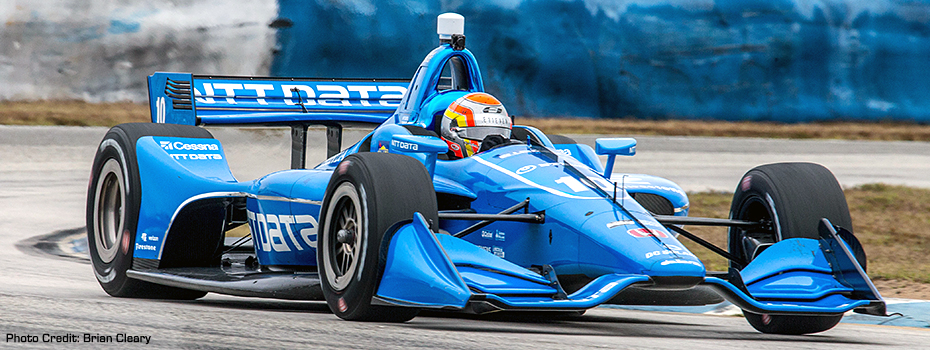SEBRING, Florida – Bryan Herta stood near an awning today at Sebring International Raceway, watching as dozens of Andretti Autosport crew members spent their lunch break working feverishly on the team’s four cars.
When asked if he’d thrown them a party for their effort, he laughed.
“Not yet,” Herta said. “They worked right up until we got here. The cars were literally being finished as they were rolling them into the trucks to bring them down here. There hasn’t been time to take a breath.”
Andretti Herta Autosport with Curb-Agajanian, the partnership between Herta and Michael Andretti’s Andretti Autosport, will field the No. 98 Honda again this year in the Verizon IndyCar Series, with one major change: Marco Andretti will drive it (with Herta calling Marco’s race strategy for a second straight year), while Alexander Rossi moves to Andretti’s previous car, the Andretti Autosport No. 27 Honda. But the underlying story of their switch is the entire team’s effort to piece together four cars with the new universal aero kit in time to get them from its Indianapolis shop to Sebring for the test session.
The term “universal aero kit” makes the 2018 car sound like the Dallara IR-12 chassis has simply been fitted with new bodywork. In reality, the change is extensive, calling for a complete rewiring of electronics, movement of radiators and movement of key elements of the turbocharger system.
 “It’s pretty amazing what they’ve been able to do,” said Ryan Hunter-Reay, who will return to Andretti Autosport for a ninth season when the 2018 campaign opens March 11 at St. Petersburg, Florida. “We got the kit late in the game and it was a complete rework, from the mounting positions to the plumbing for the turbo and where the electrical units are located in the car – everything you can think of is different. It’s a basically an all-new car.”
“It’s pretty amazing what they’ve been able to do,” said Ryan Hunter-Reay, who will return to Andretti Autosport for a ninth season when the 2018 campaign opens March 11 at St. Petersburg, Florida. “We got the kit late in the game and it was a complete rework, from the mounting positions to the plumbing for the turbo and where the electrical units are located in the car – everything you can think of is different. It’s a basically an all-new car.”
A hundred yards away in the Chip Ganassi Racing transporter, Mike Hull went over details of the new car and the manpower it took to get cars ready for Scott Dixon and Ed Jones. As managing director of CGR’s INDYCAR operation, Hull oversaw the complicated process of getting the parts and people in the right places.
“We had to have the monocoque modified to be able to accept the new bodywork and its new safety enhancements, which are really important,” Hull explained. “I think everybody now is well down the road with that part of it. The second part was fitting all the bodywork and making sure it fit right. That’s pretty labor-intensive.”
Another significant challenge for teams was acquiring and assembling the small stuff, the myriad parts and pieces that aren’t seen on the finished product.
“There are a million little parts,” Herta said. “It’s not just sidepods. The big stuff is easy. It’s all the little parts and having enough of them to get all four cars together. These guys did a great job and were able to get them put together.”
The offseason preparation, including this week’s Sebring test, is just the beginning of the effort to get the new cars ready for all aspects of the Verizon IndyCar Series schedule. Several other private team tests are scheduled over the next seven weeks, plus a series-wide open test Feb. 9-10 at ISM Raceway in Phoenix.
“The midnight oil to get ready is the down payment to where we’re all going to be as we go through all the variations of the aero kit – short oval, road course, street track, big oval,” Hull said. “That’s where the work is really going to start. … If I had to give you a number, and this is a conservative estimate, I’d say there is probably 400 to 500 hours of work per car just to get it ready for the first time.”
The rewards for the labor includes the kit’s sleek, retro styling that has drawn rave reviews. After all, if you’re going to put in extra hours, it helps if the finished product is stylish.
“It looks great,” Hunter-Reay said. “When you work that hard to put something together, how it looks is something people appreciate. People want to look at it. It’s pleasing on the eyes. So often the work these guys do doesn’t go accounted for. It’s not something that is known by the masses. We’d never turn a wheel if it wasn’t for them.”
So the party for the people who do the heavy lifting is somewhere off in the distance. But the acknowledgement of their efforts is already up to speed.
“These guys made sacrifices,” Herta said. “The shop was closed during the holidays so they could spend time with their families, but a lot of them came in anyway as the parts started arriving. Even though they were technically off, they gave up their free time to make sure we could get the cars going. That shows a lot of character.”
